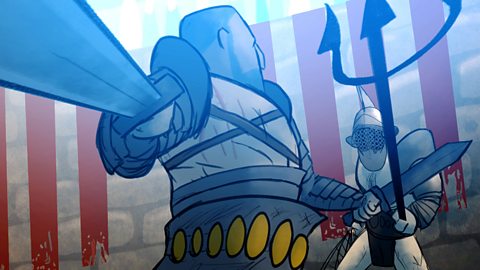NARRATOR:Britain, 600 AD. The Roman army left 200 years ago and the empire is ended. New people have come to settle here, these are the Anglo Saxons. They told some of the very first English stories.
ANGLO SAXON ELDER:There once was a king called Hrothgar, ruled a land far away over the sea. Hrothgar built a great hall, much bigger than this one, where his warriors could drink and listen to stories.
ANGLO SAXON ELDER:But an ogre, Grendel, lived in a deep dank swamp nearby.
ANGLO SAXON MAN:Argh!
ANGLO SAXON ELDER:Grendel returned whenever he felt like it, day or night.
ANGLO SAXON ELDER:A young warrior named the Beowulf, hears of Hrothgar’s troubles and sails to Hrothgar’s kingdom to help.
BEOWULF:More I hear that the monster dire in his wanton mood, reeks not weapons hence shall I scorn.
BEOWULF:Grendel doesn’t frighten me. I will fight him with my bare hands.
NARRATOR:People loved to listen to tales of warriors because it’s an important part of Anglo Saxon life.
OSRIC:What happened in the end?
ANGLO SAXON ELDER:See I said that story of Beowulf would make [Osric] feel better. Well, years later when Beowulf himself was King, a huge dragon was guarding treasure - a thief trying to steal a jewelled cup disturbed the dragon who immediately flew into a furious rage.
ANGLO SAXON ELDER:Once riled, the dragon was unstoppable.
NARRATOR:Beowulf and the dragon fight to the death. Both are slain.
ANGLO SAXON LADY:Is Osric asleep?
ANGLO SAXON LADY:He’s burning up, he has a fever.
ANGLO SAXON SISTER:Its elf shot. An elf must have shot an arrow into him.
ANGLO SAXON LADYWe must drive the arrow out. Go and fetch the leech.
NARRATOR:The leech is the Anglo Saxon word for a person who heals. The leech uses herbs, chants and lucky charms known as amulets, believed to have magical powers to make people better.
LEECH:Power against the enemy who travels over the earth.
LEECH:Power against the enemy who travels over the earth.
ANGLO SAXON LADY:It’s not working.
LEECH:I’ll try a different charm.
NARRATOR:Invisible elves are often blamed for causing illness.
ANGLO SAXON SISTER:Elf, where are you? I know you’re here somewhere. Hiding in the river? Why did you have to shoot an arrow into my little brother, you’ve made him really ill.
ANGLO SAXON SISTER:Dad!
ANGLO SAXON DAD:I’ve heard that Osric may not last this night. Well where is he?
ANGLO SAXON LADY:We’ve tried everything.
ANGLO SAXON ELDER:Amulets, chants, even stories.
ANGLO SAXON DAD:I’ve got some important news to tell you. The King has become a Christian, and I have too. If we wish to remain in his favour we must all become Christians?
ANGLO SAXON LADY:That won’t help our son.
PRIEST:Faith in Jesus Christ will make your son well again. I have Holy water. Now we must pray for your son. God will drive out the evil spirit. For God, maker of all, and King of all, that has his being beyond all…
ANGLO SAXON DAD:He is cured.
NARRATOR:Many people convert to Christianity and are baptised in water.
OSRIC:Do you think becoming a Christian is what made me better?
ANGLO SAXON SISTER:It could have been amulet that the Leech gave you. Who cares, the best thing is you’re still alive and that’s all that matters.
ANGLO SAXON SISTER:Come on you can help me feed the goats now.
OSRIC:Do we have to?
Video summary
Life in Anglo-Saxon Britain is shown through the eyes of a typical family.
One of the children is sick, and this is used as a means to explore the different approaches to medicine and medical care in Saxon times.
Which one of them is responsible for curing the sick child?
The epic tale of Beowulf is used to illustrate Anglo-Saxon beliefs and their love of stories.
This is from the series: The Story of Britain
Teacher Notes
Could be used to introduce the Anglo-Saxons and to start discussions on life and medicine during that period.
What did Anglo-Saxons do when they were ill? What did they think caused illness?
Students could be asked to list all the ways Anglo-Saxons treated sick people, using the clip.
Are there any methods we still use today? Which method did the Anglo-Saxon family think cured their son?
Which method do you think cured their son? How effective do you think Anglo-Saxon medicine was?
This clip will be suitable for teaching History at KS2 in England, KS1 and KS2 in Northern Ireland.
Also Early 1st and 2nd Level in Scotland.
Iron Age Britain. video
Exploring life in Iron Age Britain through the eyes of one family.
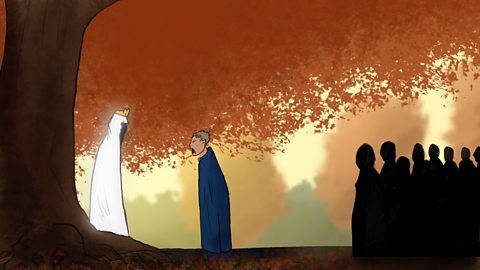
New Stone Age. video
Life in Neolithic Britain through the eyes of one family.
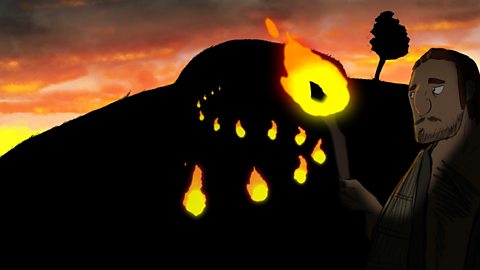
The Vikings. video
Exploring life in Viking Britain through the eyes of an Anglo-Viking family.

Domesday Book. video
Exploring 1085 and the compilation of Domesday Book.
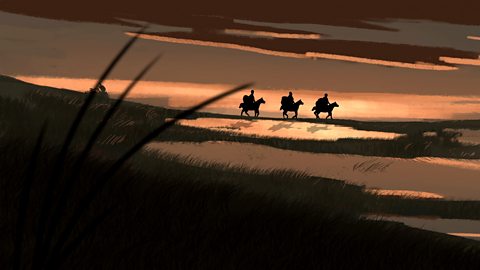
Boudica and the Roman Invasion. video
Exploring life in Britain at the time of Boudica’s rebellion through the eyes of one family.
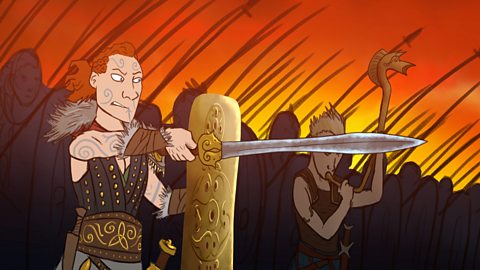
The Normans. video
Exploring British life in 1066 through the eyes of a Norman family.

Bronze Age Britain. video
Exploring life in Bronze Age Britain through the eyes of one family.

Middle Stone Age. video
Life in Middle Stone Age or Mesolithic Britain through the eyes of one family.
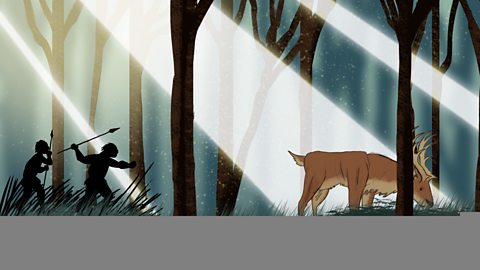
Roman Britain. video
Exploring life in Britannia through the eyes of one Roman family.
